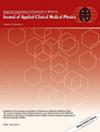A personalized tumor kV-IORT navigation system based on hybrid twin
Abstract
Purpose
This study proposes a multidimensional hybrid twin navigation system to enhance applicator placement accuracy in low-energy x-ray intraoperative radiotherapy (kV-IORT), particularly for less-experienced practitioners. The system integrates augmented reality (AR) and digital twin technologies to improve intraoperative precision and usability.
Methods
The system comprises three core modules: (1) a holographic dose (Holo-dose) model visualizing clinically relevant radiation layers based on Zeiss TARGIT data, (2) a patient-specific applicator positioning strategy with real-time AR feedback adapted to tumor bed geometry, and (3) a bidirectional hybrid twin control linking a physical radiotherapy robot with its virtual twin for precise navigation. Phantom experiments utilized a 20 mm spherical applicator within a 30 mm tumor bed boundary. Target dose range was 18.50–19.50 Gy (15 mm radius) over 25 min. Accuracy was evaluated via root mean square error (RMSE) and target registration error (TRE). Mean RMSE was 0.383 mm (phantom) and 0.106 mm (robot); mean TRE was 0.41 mm.
Results
The system significantly enhanced positioning accuracy for novice users. Medical students achieved an average precision of 2.971 mm (p = 0.00015), and inexperienced physicians reached 2.803 mm (p = 0.00038). No significant improvement was observed for experienced surgeons (p > 0.05), indicating the system's potential as a training and assistance tool. The average System Usability Scale (SUS) score was 83.5, suggesting high user satisfaction, especially among younger participants.
Conclusions
The hybrid twin navigation system significantly improved applicator placement accuracy for novice users, demonstrating its value as an effective training and assistance tool for kV-IORT. High user satisfaction and sub-millimeter registration and alignment accuracy confirm its potential for clinical translation, particularly in enhancing usability and precision for less-experienced practitioners.





 求助内容:
求助内容: 应助结果提醒方式:
应助结果提醒方式:


